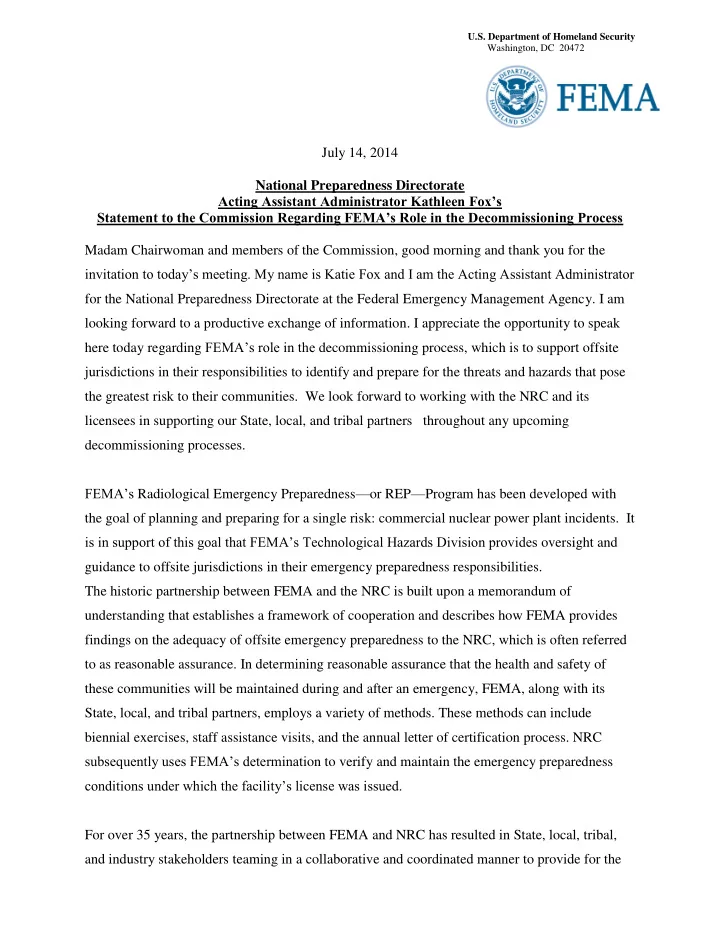

U.S. Department of Homeland Security Washington, DC 20472 July 14, 2014 National Preparedness Directorate Acting Assistant Administrator Kathleen Fox’s Statement to the Commission Regarding FEMA’s Role in the Decommissioning Process Madam Chairwoman and members of the Commission, good morning and thank you for the invitation to today’s meeting. My name is Katie Fox and I am the Acting Assistant Administrator for the National Preparedness Directorate at the Federal Emergency Management Agency. I am looking forward to a productive exchange of information. I appreciate the opportunity to speak here today regarding FEMA’s role in the decommissioning process, which is to support offsite jurisdictions in their responsibilities to identify and prepare for the threats and hazards that pose the greatest risk to their communities. We look forward to working with the NRC and its licensees in supporting our State, local, and tribal partners throughout any upcoming decommissioning processes. FEMA’s Radiological Emergency Preparedness — or REP — Program has been developed with the goal of planning and preparing for a single risk: commercial nuclear power plant incidents. It is in support of this goal that FEMA’s Technological Hazards Division provides oversight and guidance to offsite jurisdictions in their emergency preparedness responsibilities. The historic partnership between FEMA and the NRC is built upon a memorandum of understanding that establishes a framework of cooperation and describes how FEMA provides findings on the adequacy of offsite emergency preparedness to the NRC, which is often referred to as reasonable assurance. In determining reasonable assurance that the health and safety of these communities will be maintained during and after an emergency, FEMA, along with its State, local, and tribal partners, employs a variety of methods. These methods can include biennial exercises, staff assistance visits, and the annual letter of certification process. NRC subsequently uses FEMA’s determinati on to verify and maintain the emergency preparedness conditions under which the facility’s license was issued. For over 35 years, the partnership between FEMA and NRC has resulted in State, local, tribal, and industry stakeholders teaming in a collaborative and coordinated manner to provide for the
safety and security of citizens residing in the 10- and 50-mile emergency planning zones surrounding these plants. Together, we provide regulations, guidance, and policy that direct the planning, training, and exercising activities of the participants in this program. In sum, these joint activities have ensured that offsite jurisdictions have the capability and resources to prepare for the risk posed by a nuclear power plant. Of course effective preparedness is not an end-state; it is a process. As threats and hazards evolve, so too must planning, capabilities, and resources. In recent months, four nuclear power plants — Kewaunee, Vermont Yankee, Crystal River, and San Onofre — have indicated the intention to enter the decommissioning process and are currently at various stages of petitioning the NRC for exemptions. If granted, these exemptions could remove regulatory requirements and allow for changes in offsite radiological planning. Decommissioning a power plant could impact the risk profile of a jurisdiction and, as such, might impact both offsite and onsite emergency preparedness programs. As a facility undergoes decommissioning, both FEMA and the NRC expect that surrounding jurisdictions will respond to any changing risk conditions with appropriate adjustments to their plans, capabilities, and resources. In order to do so, it is imperative that State, local, and tribal stakeholders be provided with timely and accurate information regarding the changing risk conditions at the facility. This type of information will then enable offsite jurisdictions to comprehensively analyze and understand the threats and associated risks they face. One methodology commonly employed is the Threat and Hazard Identification and Risk Assessment — or THIRA — process, which examines communities’ threats and hazards of greatest concern , and identifies the capabilities required to address those risks. We will continue to support offsite organizations as they adjust their plans, capabilities, and resources to the changing radiological threat. While a decision reached by the Commission regarding the Kewaunee Power Station exemption will be specific to that site, it may establish guidelines for upcoming exemption requests. Our goal is to continue our decades-long collaboration with the Commission and its licensees throughout any decommissioning process and ensure that careful attention is given to the effects on State, local, and tribal jurisdictions – effects that will likely include adjustments to emergency plans and resources prior to any potential exemption approvals taking effect. Much has changed since decommissioning last occurred in the 1990s. In the years since, we have seen an evolution in the fundamental approach to emergency preparedness. In light of evolving emergency preparedness doctrine, FEMA stands ready to assist the NRC in the development of 2
decommissioning guidance that will allow for secure and resilient communities, prepared to protect against the full spectrum of threats – from natural to terrorist-based. It is with a foundation in the mandate given to FEMA 35 years ago, the principles of the National Preparedness System, and the partnership between FEMA and the NRC, that we look forward to continuing to work closely with the NRC on decommissioning activities. We strongly encourage NRC and its licensees to work with State, local, and tribal communities in their determinations of risk, threat, and public safety. Continued and synchronized engagement among all parties throughout any decommissioning process is a logical extension of existing partnerships and is necessary to provide for the health and safety of all citizens. Thank you again for the opportunity to engage on this issue and I look forward to discussion with the other participants in today’s meeting. 3
Recommend
More recommend